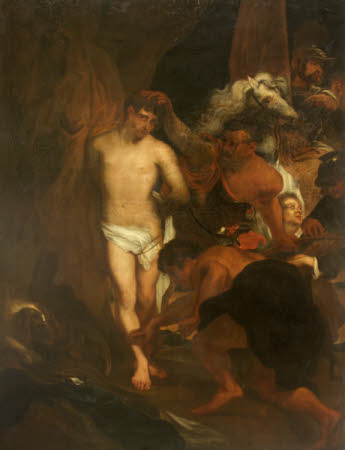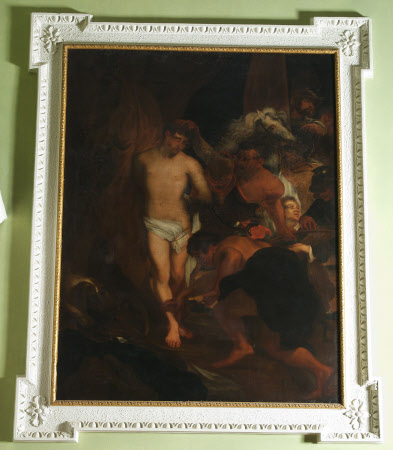Saint Sebastian bound for Martyrdom (after Van Dyck)
Isaac Seeman (fl.1739 – London 1751)
Category
Art / Oil paintings
Date
1746
Materials
Oil on canvas
Measurements
2007 x 1536 mm (79 x 60 1/2 in)
Place of origin
England
Order this imageCollection
Lacock, Wiltshire
NT 996271
Caption
Saint Sebastian was a third-century Christian martyr, and a member of the Roman Emperor, Diocletian’s guard. He survived the first attempt on his life with arrows, and died only when beaten to death with clubs, after which his body was thrown into the Roman sewers. The painting is a copy after Van Dyck’s picture in the Alte Pinakothek, Munich, which was painted early on in his time in Italy, in 1622 or 1623. Saint Sebastian is popular as an intercessor against the plague (of which arrows from heaven were a symbol). Van Dyck’s composition is unusual, for he is usually shown pierced with arrows.
Summary
Oil painting on canvas, Saint Sebastian bound for Martyrdom (after Van Dyck) by Isaac Seeman (d.1751). Presents Sebastian gazing at the viewer as he is prepared for execution: he is bound to a tree by two executioners, with his feet still being tied together by the figure to the centre-right. To the far right, a helmeted soldier prepares his bow. Bottom left, a dog guards the saint’s discarded robes and armour. A copy of a picture painted by Van Dyck (1599-1641) early on in his time in Italy (c.1622-23) now in the Alte Pinakothek, Munich. Other versions can be found at the Weiss Gallery, Chrysler Museum and National Gallery of Scotland. This painting was commissioned by John Ivory Talbot for £4.10.0 plus £1.5.0 for 'Lineing & stretching frame'.
Full description
The slender figure of the young St. Sebastian (with features that have been compared to a dark-haired version of the young Van Dyck himself) confronts the viewer with his gaze as he is bound to a tree by two swarthy executioners. Sebastian’s pale skin and composure isolate him on the left of the painting, along with the dog guarding the saint’s discarded robes and armour in the bottom left. Horsemen and other figures fill the upper right of the picture, with a helmeted soldier preparing his bow to the centre-right. A version without the horsemen group in the upper-right was owned by Hall & Knight and then by the Weiss Gallery, where it appeared as catalogue entry 16 in the Historical Reflections: Early Portraiture 1520 – 1780 exhibition in 2007. Another copy of this picture is in the Chrysler Museum, Norfolk, Virginia. Being first recorded in 1810, in the collection of Walsh Porter, in England, this picture could have had an earlier English provenance and been the version the Lacock picture was copied after. The National Gallery in Scotland holds another version (NG 121). Saint Sebastian was a 3rd-century Christian martyr, and a member of Diocletian’s guard. He survived the first attempt on his life with arrows, and died only when beaten to death with clubs, after which his body was thrown into the Cloaca Maxima. He is popular as an intercessor against the plague (of which arrows from heaven were a symbol). Van Dyck’s composition is unusual, for he is usually shown pierced with arrows. Precedents can be found in an altarpiece by Cobergher in Antwerp Cathedral, and in a print after Palma Giovane by Aegidius Sadeler.
Provenance
Bill and receipt (August 28th 1746) from Isaac Seeman, at a cost of £6.0.0 plus £1.10.0 for 'Lineing & stretching frame' (Swindon and Wiltshire History Centre 2664/Box 50/OB18; information given by Elizabeth Gibb); thence by descent and inheritance; given by Matilda Theresa Talbot (formerly Gilchrist-Clark) (1871 – 1958), who gave the Abbey, the village of Lacock and the rest of the estate to the National Trust in 1944, along with 96 of the family portraits and other pictures, in 1948
Credit line
Lacock Abbey, The Talbot Collection (National Trust)
Makers and roles
Isaac Seeman (fl.1739 – London 1751), artist after Sir Anthony Van Dyck (Antwerp 1599 - London 1641), artist
References
Barnes 2004: Susan Barnes, Van Dyck. A Complete Catalogue of the Paintings, New Haven & London, 2004, pp.163-4 Webley 2022: John Webley, The Seeman family of artists from Danzig, 2022

